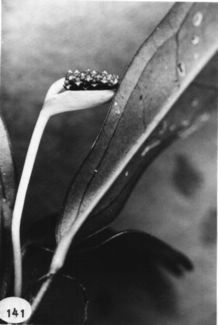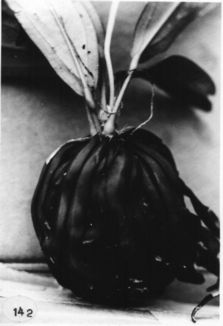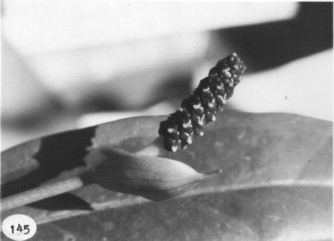






Anthurium platyrhizum Croat, sp. nov.
TYPE: Panama. Col—n: along drainage of Río Gatun, António 3853 (MO 2801415, holotype;PMA, isotype; Live at K, MO).
Planta epiphytica; radices camplanatis; cataphyllum coriaceum subpersistens; petiolus leviter camplanatus
ad leviter sulcatus, 4-11 cm longus; lamina anguste elliptica ad oblanceolato-elliptica, basi acuta ad obtusa aut rotundata, 17-30 cm longa, 4.3-8.7 cm lata; inflo-rescentia effusa; pedunculus 10.5-26 cm longus, teres; spatha subcoriacea, viridis, ovata, 2.6-4.5 cm longa, 1.5-2 cm lata; spadix atrovirens, 1.6-3.5 cm longus; baccae violaceo purpureae, ovoideae, ca. 8 mm longae.
Epiphyte; stems very short, green; leaf scars ca. 8 mm wide; roots dense, greenish brown, flat, 5-8 mm wide; cataphylls coriaceous, 1.5-3.7 cm long, drying brown with a raised medial rib, acute and apiculate at apex, the apiculum ca. 1.5 mm long, drying tan (B & K Yellow 6/5), splitting at base, intact at apex, subpersistent.
LEAVES spreading; petioles 4÷11 cm long, 2-3 mm diam., weakly flattened to shallowly sulcate adaxially; 9geniculum 1-1.7 cm long; blades narrowly elliptic to oblanceolate-elliptic, acuminate at apex, acute to obtuse or rounded at base, 17-30 cm long, 4.3-8.7 cm wide, broadest at the middle; upper surface matte to semiglossy, lower surface semiglossy; midrib weakly raised at base above, diminished and sunken at apex, prominent and convexly raised below; primary lateral veins 4÷ 6 per side, departing the midrib at 45-55° angle, flat to weakly sunken above, nearly obscure in older leaves, prominulous below, more or less straight to collective vein; lesser veins obscure above, flat below; collective vein arising from near the base, sometimes extending along midrib at base for up to 2 cm before branching out to form collective vein, 0.4÷1 cm from margin, sunken above, raised below.
INFLORESCENCE spreading, usually shorter than leaves; peduncle 10.5-26 cm long, 2-3.5 mm diam., terete, 2-5 times longer than petioles; spathe subcoriaceous, green (B & K Yellow-green 6/7.5), ovate 2.6-4.5 cm long, 1.5-2 cm wide, broadest just below middle, abruptly acuminate at apex, rounded to acute at base; stipe pale green, 1-1.7 cm long, 2-4 mm diam.; spadix dark green (B & K Green 5/2.5), scarcely tapered at apex, 1.6-3.5 cm long, 5-8 mm diam. midway, the flowers 4-lobed, 4-4.5 mm long, 5-5.5 mm wide, the sides jaggedly sigmoid, 3-4 flowers visible in the principal spiral, 4÷5 flowers visible in the alternate spiral; tepals glossy with obscure, pale punctations, minute droplets apparent at anthesis, lateral tepals ca. 2 mm wide, the inner margin weakly rounded; pistils emergent ca. 1 mm, whitish, translucent, pointed, sometimes tinged violet purple near edges of tepals; stigma broadly elliptic, 0.5-0.6 mm long, with small clear droplets apparent 1-2 days before stamens emerge; stamens emerging beginning from the base, laterals first, emerging to midway before alternates emerge, exserted on short, translucent filaments, retracting and held at edge of tepals in a close but noncontiguous circle around pistil; anthers yellow, ca. 0.6 mm long, 0.5 mm wide; thecae oblong, slightly divaricate; pollen bright orange fading to pale orange to tan.
INFRUCTESCENCE with berries ovoid, ca. 8 mm long, 4 mm diam., violet purple, rounded at apex; seeds not seen. Figs. 141, 142, and 145.
Anthurium platyrhizum is known only from Panama (though it is to be expected in Colombia) and has been collected from the Atlantic slope in the Provinces of Col—n and San Bias from near sea level to 600 m in premontane and tropical wet forest.
The species was first collected by Helen Kennedy who sent living material of the species to Kew Gardens where it set fruit. Living material was later sent to the Missouri Botanical Gardens by Tom António. It is recognized by narrowly elliptic, epunctate leaf blades and the dense mass of conspicuously flattened roots (hence the name platyrhizum). Other distinguishing features include its green, boat-shaped, acuminate spathe. its dark green, short-cylindroid spadix with markedly raised tepals, its prominently exserted style, and its violet purple berries.
Anthurium platyrhizum is most closely related to A. llanense ssp. llanense, which has similar leaves and flowers; the latter taxon, however, has a more or less globose spadix, regular, slender, terete roots, and has the collective vein arising from very near the base of the leaf. In A. platyrhizum, the collective veins extend upward along the midrib for some distance from the base before diverging as the collectives.
Anthurium platyrhizum is also closely related to A. wedelianum, which has very similar leaves but has a much longer, tapered spadix, has flowers that are not markedly raised, and lacks deep channels between the tepals.
The sectional placement of all the above species is in doubt, but they have been tentatively placed in section Urospadix.
 |
 |
 |
Panama: COLON: Río Gatun, António 3853 (MO, PMA); ridge between Río Piedras & Río Gatun, Sytsma et al. 4306 (MO);
Santa Rita Ridge, Kennedy 2730 (F, K, MO), Knapp et al. 1731 (MO).
Panama: San Blas: on trail to Darien from Puerto Obaldia, Mori et al. 6861 (MO).